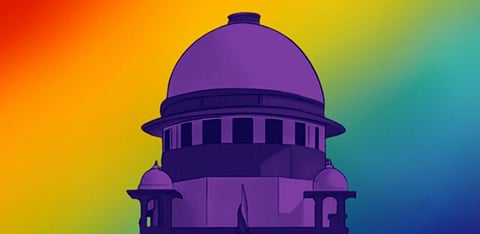

As the Supreme Court gets ready to pronounce judgment in the marriage equality case tomorrow, we present the background, main issues and a blow-by-blow account of the hearings that took place in April this year in what might turn out to be a historic movement for LGBTQI+ rights in India.
—
On April 18, a Supreme Court Constitution Bench headed by Chief Justice of India Dr D.Y. Chandrachud and also comprising Justices S.K. Kaul, S. Ravindra Bhat, Hima Kohli and P.S. Narasimha, began hearing a batch of petitions in Supriyo@Supriya Chakraborty versus Union of India & Ors, which claim marriage equality in India. The hearing went on for ten days. Here is a brief account of the issues, the lead-ups and each day of the hearings.
Highlights
Who said what
Highlights
Who said what
Highlights
Who said what
A feisty long weekend
Highlights
Who said what
Highlights
Who said what
Highlights
Who said what
Highlights
Who said what
Highlights
Who said what
Highlights
Who said what
Highlights
Who said what
| Issues raised | Argument | Counter-argument | Supreme Court |
| Marriage a subject on the Concurrent List | Respondent: Solicitor General Mehta raised the plea that states and Union territories must be impleaded as parties, else the petitions would not be maintainable. | Petitioners: A petition under Article 32 of the Constitution for the violation of fundamental rights does not become bad upon non-joinder of states. | Has not issued notices to states and Union territories. It did not go into the argument of whether the opinion of states is necessary in this matter. |
| How should the court go about hearing the petitions? | Petitioners: Some explicit rights must be given. Petitioners cannot wait for the Parliament to enact laws while their lives pass by. | Respondent: Hear all issues or hear none as the issues are interrelated and impact personal laws. The case has an adversarial impact on the legislative rights of states. | Has adopted an incremental approach, limiting the canvas to the Special Marriage Act to accommodate gender-neutral situations. |
| Positive affirmation | Petitioners: Decriminalisation of homosexuality grants a negative right. The next step should be positive affirmation. That can only be ensured by granting the full panoply of rights under Articles 14, 15, 19 and 21 of the Constitution, including the right to marry. Grant more than just a mere declaration to marry. Consequential benefits must flow out of this right. | Respondent: Marriage was not an issue raised in Navtej Singh Johar. The government has already enacted the Transgender Persons (Protection of Rights) Act, 2019, protecting rights of dignity and sexual orientation, and prohibiting discrimination on the basis of gender. There is a conscious omission in the legislation in the context of marriage. | On one hand, society cannot accept that non-heteronormative individuals are entitled to choose a partner, while on the other hand depriving them of the benefits of the conventional social institution of marriage. |
| Non-heteronormative marriage | Petitioners: Marital status is a source of dignity and self-respect as a core member of the society. The lack of protection for non-heteronormative couples (afforded by the institution of marriage) is sufficient in creating unconstitutionality because it is not based on intelligible differentia.
| Defendants: Marriage can only happen between a biological man and a biological woman. The concept of non-heteronormative marriage is merely an urban elitist view. | By decriminalising homosexuality, the court necessarily contemplated homosexual couples to be in stable, marriage-like relationships. The court will have to see whether the law has progressed enough to contemplate that the existence of binary gender is not necessary for the definition of marriage. The Union government says non-heteronormative marriage is an elitist view but no data has been furnished to prove that. The State cannot discriminate against an individual on the basis of characteristics over which the person has no control. |
| Special Marriage Act | Petitioners: Whether marriage is a legal or religio-cultural concept: The Special Marriage Act is an areligious or non-religious marriage-related legislation. Terminology: Certain provisions can be amended to replace the terms 'husband' and 'wife' with 'spouse', and 'male' and 'female' with 'person'. Marriageable age: In cases of homosexual couples, the age will depend on what gender the person professes. Degree of prohibited relationship: For same-sex couples, it could be determined through a harmonious interpretation of Parts I and Part II of the First Schedule of the Act. Notice signifying the intention to marry: The thirty-day notice period to be given before marriage to a district marriage officer is a violation of decisional privacy. | Respondent: Whether marriage is a legal or religio-cultural concept: The underlying meaning of marriage is understood from the perspective of personal laws. Terminology: Even though certain sections of the Special Marriage Act use the term 'person', the legislative intent throughout is the recognition of marriage between a biological male and a biological female. | Terminology: There is no absolute concept of a man or a woman. It is a far more complex concept than a mere matter of genitalia. Degree of prohibited relationship: If two men or two women are getting married, not just Part I but also Part II of the First Schedule under the Special Marriage Act would apply. This is also a tacit indication that the Special Marriage Act did not contemplate people of the same sex getting married. Notice signifying the intention to marry: The thirty-day notice period is patriarchal and was added when women did not have agency. |